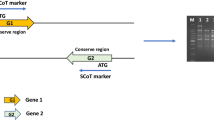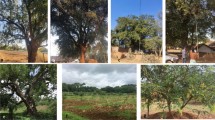Abstract
Akebia trifoliata (Lardizabalaceae) is an important medicinal plant with multiple pharmacological effects. However, the lack of genomic information had limited the further excavation and utilization of this plant. An initial survey of the genome A. trifoliata was performed by next-generation sequencing, and then the genome size was inferred by flow cytometry. The whole genome survey of A. trifoliata generated 61.90 Gb of sequence data with approximately 95.51 × coverage. The genome size, heterozygosity and GC content obtained by k-mer analysis were almost 648.07 Mb, 0.72% and 36.11%, respectively. The genome size calculated by flow cytometry was 685.77 Mb, which was consistent with the results of genome survey. A total of 851,957 simple sequence repeats (SSR) were identified in the A. trifoliata genome. Twenty-eight phenotypic traits and thirty pairs of SSR primers were selected for the analysis of the genetic diversity of 43 accessions of cultivated A. trifoliata. The results showed that 216 bands were generated by 30 pairs of SSR primers, of which 189 (87.5%) were polymorphic. In addition, the phenotypes and SSR markers were used for cluster analysis of 43 cultivated accessions. The results of the two clustering methods were partially consistent. The genome survey of A. trifoliata demonstrated that the genome size of this plant was about 648.07 Mb. In the present study, the size and characteristics of the genome of A. trifoliata were reported for the first time, which greatly enriched the genomic resources of A. trifoliata for the further research and utilization.





Similar content being viewed by others
Data availability
The genome sequence reads obtained by Illumina Hiseq 2500 are available at NCBI-SRA. The Bioproject accessions number is PRJNA667569, and the Biosample accessions number is SAMN16378157. The Experiment number is SRX9274273/ The Run number is SRR12805495.
References
Chinese Flora Commission (2001) Flora of China. Science Press, China, p 8
National Pharmacopoeia Committee (2020) Chinese pharmacopoeia. China Medical Science and Technology Press, Beijing, p 297
Lu WL, Yang T, Song QJ, Fang ZQ, Pan ZQ, Liang C, Jia DW, Peng PK (2018) Akebia trifoliata (Thunb.) Koidz seed extract inhibits human hepatocellular carcinoma cell migration and invasion in vitro. J Ethnopharmacol 234:204–215. https://doi.org/10.1016/j.jep.11.044
Li L, Chen XZ, Yao XH, Tian H, Huang HW (2010) Geographic distribution and resource status of three important Akebia species. J Wuhan Bot Res 28(4):497–506. https://doi.org/10.3724/SP.J.1142.2010.40497
Motalebipour EZ, Kafkas S, Khodaeiaminjan M, Çoban N, Gözel H (2016) Genome survey of pistachio (Pistacia vera L.) by next generation sequencing: development of novel SSR markers and genetic diversity in Pistacia species. BMC Genomics 17(1):998. https://doi.org/10.1186/s12864-016-3359-x
Wang CR, Yan HD, Li J, Zhou SF, Liu T, Zhang XQ, Huang LK (2018) Genome survey sequencing of purple elephant grass (Pennisetum purpureum Schum ‘Zise’) and identification of its SSR markers. Mol Breed 38(7):94. https://doi.org/10.1007/s11032-018-0849-3
Lu M, An HM, Li LL (2016) Genome survey sequencing for the characterization of the genetic background of rosa roxburghii tratt and leaf ascorbate metabolism genes. PLoS ONE 11(2):e0147530. https://doi.org/10.1371/journal.pone.0147530
Shi LL, Yi SK, Li YH (2018) Genome survey sequencing of red swamp crayfish Procambarus clarkii. Mol Biol Rep 45(5):799–806. https://doi.org/10.1007/s11033-018-4219-3
Zhou W, Li B, Li L, Ma W, Liu YC, Feng SC, Wang ZZ (2018) Genome survey sequencing of Dioscorea zingiberensis. Genome 61(8):567–574. https://doi.org/10.1139/gen-2018-0011
Anju B, Kalpalatha M, Sathya E, Julian J, Umesh R (2019) Characterization of strawberry (Fragaria spp.) accessions by genotyping with SSR markers and phenotyping by leaf antioxidant and trichome analysis. Sci Horticulturae 256:1–7. https://doi.org/10.1016/j.scienta
Da Silva BSR, Sant’Ana GC, Chaves CL et al (2019) Population structure and genetic relationships between Ethiopian and Brazilian Coffea arabica genotypes revealed by SSR markers. Genetica 147(2):205–216. https://doi.org/10.1007/s10709-019-00064-4
Li GQ, Song LX, Jin CQ, Li M, Gong SP, Wang YF (2019) Genome survey and SR analysis of Apocynum venetum. Biosci Rep 39(6):1–11. https://doi.org/10.1042/BSR20190146
Liu WC, Xu YT, Li ZK, Fan J, Yang Y (2019) Genome-wide mining of microsatellites in king cobra (Ophiophagus hannah) and cross-species development of tetranucleotide SSR markers in Chinese cobra (Naja atra). Mol Biol Rep 46(6):6087–6098. https://doi.org/10.1007/s11033-019-05044-7
Tuler AC, Carrijo TT, Nóia LR, Ferreira A, Peixoto AL, da Silva Ferreira MF (2015) SSR markers: a tool for species identification in Psidium (Myrtaceae). Mol Biol Rep 42(11):1501–1513. https://doi.org/10.1007/s11033-015-3927-1
Meinke DW, Cherry JM, Dean C, Rounsley SD, Koornneef M (1998) Arabidopsis thaliana: a model plant for genome analysis. Science 282(5389):679–682. https://doi.org/10.1126/science.282.5389.662
Dpooležel J, Binarová P, Lcretti S (1989) Analysis of Nuclear DNA content in plant cells by Flow cytometry. Biol Plant 31(2):113–120. https://doi.org/10.1007/BF02907241
Li RQ, Fan W, Tian G, Zhu H, He L et al (2010) The sequence and de novo assembly of the giant panda genome. Nature 463:311–317. https://doi.org/10.1038/nature08696
Marcais G, Kingsford C (2011) A fast, lock-free approach for efficient parallel counting of occurrences of k-mers. Bioinformatics 27(6):764–770. https://doi.org/10.1093/bioinformatics/btr011
Varshney RK, Chen W, Li Y et al (2011) Draft genome sequence of pigeonpea (Cajanus cajan), an orphan legume crop of resource-poor farmers. Nat Biotechnol 30(1):83–89. https://doi.org/10.1038/nbt.2022
Zhou W, Hu YY, Sui ZH, Fu F, Wang JG, Chang LP, Guo WH, Li BB (2013) Genome survey sequencing and genetic background characterization of Gracilariopsis lemaneiformis (Rhodophyta) based on next-generation sequencing. PLoS ONE 8(7):e69909. https://doi.org/10.1371/journal.pone.0069909
Altschul SF, Gish W, Miller W, Myers EW, Lipman DJ (1990) Basic local alignment search tool. J Mol Biol 215(3):403–410. https://doi.org/10.1016/S0022-2836(05)80360-2
Salamov AA, Solovyev VV (2000) Ab initio gene finding in Drosophila genomic DNA. Genome Res 10(4):516–522
Stanke M, Keller O, Gunduz I, Hayes A, Waack S, Morgenstern B (2006) AUGUSTUS: ab initio prediction of alternative transcripts. Nucleic Acids Res 34:W435-439. https://doi.org/10.1093/nar/gkl200
Kailwaqen J, Hartunq F, Paulini M, Twardziok SO, Grau J (2018) Combining RNA-seq data and homology-based gene prediction for plants, animals and fungi. BMC Bioinform 19(1):189–201. https://doi.org/10.1186/s12859-018-2203-5
Haas BJ, Papanicolaou A, Yassour M et al (2013) De novo transcript sequence reconstruction from RNA-seq using the Trinity platform for reference generation and analysis. Nat Protoc 8(8):1494–1512. https://doi.org/10.1038/nprot.2013.084
Tang SY, Lomsadze A, Borodovsky M (2015) Identification of protein coding regions in RNA transcripts. Nucleic Acids Res 43(12):e78. https://doi.org/10.1093/nar/gkv227
Kent WJ (2002) BLAT-the BLAST-like alignment tool. Genome Res 12(4):656–664. https://doi.org/10.1101/gr.229202
Marchlerbauer A, Anderson JB, Cherukuri PF et al (2005) CDD: a Conserved Domain Database for protein classification. Nucleic Acids Res 33:D192–D196. https://doi.org/10.1093/nar/gki069
Boeckmann B, Bairoch A, Apweiler R et al (2003) The SWISS-PROT protein knowledgebase and its supplement TrEMBL in 2003. Nucleic Acids Res 31(1):365–370. https://doi.org/10.1093/nar/gkg095
Tatusov RL, Fedorova ND, Jackson JD et al (2003) The COG database: an updated version includes eukaryotes. BMC Bioinform 4:41. https://doi.org/10.1186/1471-2105-4-41
Dimmer EC, Huntley RP, Alam-Faruque Y et al (2012) The UniProt-GO annotation database in 2011. Nucleic Acids Res 40:D565–D570. https://doi.org/10.1093/nar/gkr1048
Kanehisa M, Goto S (2000) KEGG: kyoto encyclopaedia of genes and genomes. Nucleic Acids Res 28(1):27–30. https://doi.org/10.1093/nar/28.1.27
Thiel T, Michalek W, Varshney R (2003) Exploiting EST databases for the development and characterization of gene-derived SSR-markers in barley (Hordeum vulgare L.). Theor Appl Genet 106(3):411–422. https://doi.org/10.1007/s00122-002-1031-0
Xiong DS, Zhu JT, Li X, Chen XT, Xiong YS (2000) The Karyotype of Akebia trifoliata. Chin Wild Plant Resour 19(6):18–20
Chen RY (2009) Chromosome atlas of major economic plants genome in China. Science Press, China, p 351
Xiao J, Zhao J, Liu MJ, Liu P, Dai L, Zhao ZH (2015) Genome-wide characterization of simple sequence repeat (SSR) loci in Chinese jujube and jujube SSR primer transferability. PLoS ONE 10(5):e0127812. https://doi.org/10.1371/journal.pone.0127812
Velasco R, Zharkikh A, Affourtit J et al (2010) The genome of the domesticated apple (Malus × domestica Borkh). Nat Genet 42(10):833–839. https://doi.org/10.1038/ng.654
Rasch EM (1985) DNA “standards” and the range of accurate DNA estimates by Feulgen absorption microspectrophotometry. Prog Clin Biol Res 196:137–166
Lingohr E, Frost S, Johnson RP (2009) Determination of bacteriophage genome size by pulsed-field gel electrophoresis. Methods Mol Biol 502:19–25. https://doi.org/10.1007/978-1-60327-565-1-3
Zhu DM, Song W, Yang K et al (2012) Flow cytometric determination of genome size for eight commercially important fish species in China. In Vitro Cell Dev Biol Anim 48(8):507–517. https://doi.org/10.1007/s11626-012-9543-7
Huo KS, Zhao DL, Chen YL, Zhou ZL, Wang Y, Tang J, Zhu GP, Cao QH (2018) Analysis of genome size and characteristics of salt-tolerant Plant Ipomoeapes-caprae (L.) R.Brown. J Plant Genet Resour 20(3):728–735. https://doi.org/10.13430/j.cnki.jpgr.20180816001
Aird D, Ross MG, Chen WS, Danielsson M, Fennell T, Russ C, Jaffe DB, Nusbaum C, Gnirke A (2011) Analyzing and minimizing PCR amplification bias in Illumina sequencing libraries. Genome Biol 12(2):R18. https://doi.org/10.1186/gb-2011-12-2-r18
Bi QX, Zhao Y, Cui YF, Wang LB (2019) Genome survey sequencing and genetic background characterization of yellow horn based on next-generation sequencing. Mol Biol Rep 46(4):4303–4312. https://doi.org/10.1007/s11033-019-04884-7
Ding XP, Mei WL, Huang SZ, Wang H, Zhu JH, Hu W, Ding ZH, Tie WW, Peng SQ, Dai HF (2018) Genome survey sequencing for the characterization of genetic background of Dracaena cambodiana and its defense response during dragon’s blood. PLoS ONE 13(12):e0209258. https://doi.org/10.1371/journal.pone.0209258
An JY, Yin MQ, Zhang Q, Gong DT, Jia XW, Guan YJ, Hu J (2017) Genome survey sequencing of Luffa Cylindrica L. and microsatellite high resolution melting (SSR-HRM) analysis for genetic relationship of Luffa genotypes. Int J Mol Sci 18(9):e1942. https://doi.org/10.3390/ijms18091942
Song QJ, Shi JR, Singh S, Fickus EW, Costa JM, Lewis J, Gill BS, Ward R, Cregan PB (2005) Development and mapping of microsatellite (SSR) markers in wheat. Theor Appl Genet 110(3):550–560. https://doi.org/10.1007/s00122-004-1871-x
Kumar J, Agrawal V (2017) Analysis of genetic diversity and population genetic structure in Simarouba glauca DC. (an important bio-energy crop) employing ISSR and SRAP markers. Ind Crop Prod 100:198–207. https://doi.org/10.1016/j.indcrop.2017.02.035
Fu HF, Lv XH, Cheng JY, Li GJ (2018) Analysis of genetic diversity of phenotypic traits and SSR molecular markers in pepper germplasm. J Nucl Agric Sci 32(7):1309–1319. https://doi.org/10.11869/j.issn.100-8551
Chen K, Pachter L (2005) Bioinformatics for whole-genome shotgun sequencing of microbial communities. PLoS Comput Biol 1(2):106–112. https://doi.org/10.1371/journal.pcbi.0010024
Roberts RJ, Carneiro MO, Schatz MC (2013) The advantages of SMRT sequencing. Genome Biol 14(7):405–409. https://doi.org/10.1186/gb-2013-14-6-405
Funding
This work was supported by the Key Program of Science and Technology of Shaanxi Province, China (Project No.2013K14-03-01).
Author information
Authors and Affiliations
Contributions
Conceived and designed the experiments: ZZ. Conducted the experiments: ZZ BL WZ. Analyzed the data: JWZ QY ZZ. Contributed reagents/materials/analysis tools: ZZ. Wrote the paper: JWZ.
Corresponding author
Ethics declarations
Conflict of interest
The authors declare no conflict of interest.
Ethical approval
This article does not contain any studies with human participants or animals performed by any of the authors.
Additional information
Publisher's Note
Springer Nature remains neutral with regard to jurisdictional claims in published maps and institutional affiliations.
Supplementary information
Below is the link to the electronic supplementary material.
Rights and permissions
About this article
Cite this article
Zhang, Z., Zhang, J., Yang, Q. et al. Genome survey sequencing and genetic diversity of cultivated Akebia trifoliata assessed via phenotypes and SSR markers. Mol Biol Rep 48, 241–250 (2021). https://doi.org/10.1007/s11033-020-06042-w
Received:
Accepted:
Published:
Issue Date:
DOI: https://doi.org/10.1007/s11033-020-06042-w




